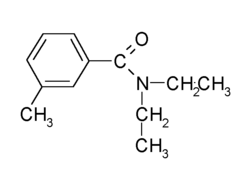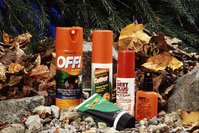SANDESTIN, FLA. -- DEBT-containing insect repellents are the best for protecting children and adults from bug bites, but the lowest effective concentration should be used, Dr. Adelaide A. Hebert said at a meeting of the Alabama Dermatology Society.
For children, N,N-diethyl-mtoluamide (DEET) concentrations should not exceed 10%, which will protect against mosquitoes, gnats, flies, chiggers, ticks, and some other insects for a few hours. The repellent should be applied sparingly and infrequently because of the risk of toxicity; said Dr. Hebert, professor and vice chairman of dermatology at the University of Texas, Houston.
In its 40 years on the market, DEET has proved relatively safe overall, but there have been reports of toxicity in children. In at least 13 cases, children under 8 years of age developed encephalopathy after using the chemical, and three children died. Many cases were linked to use of products with concentrations above 10% and with repeated applications.
Dr. Hebert reflected on several cases that she has seen over the years in which children were in unexplained comas; she speculated that some of these cases may have been the result of DEET toxicity.
Oral ingestion of DEET increases the risk of toxicity, and in some cases DEET has caused severe skin reactions in the areas where it was applied.
Another concern is DEET's flammability. Summertime activities often include outdoor flames--as with campfires or candies used outdoors--so this is a particular risk.
For adults, DEET products are available in concentrations from 4% to 100%. Toxicity has occurred far less often in adults, but it's still best to avoid the higher concentrations if possible, Dr. Hebert said.
When advising patients about how best to use DEETcontaining products, be sure to give them the chemical name: N,N-diethyl-m-toluamide or N,N-diethyl-3-methylbenzamide. Most product labels use one of these names rather than the word DEET.
Among Dr. Hebert's picks for the best DEET-containing products are Off! Skintastic lotion (8% DEET) and Skedaddle! (6.5% DEET), which is no longer being made but is still on the shelves in many stores.
Other insect repellents that do not contain DEET have some efficacy as well. Citronella, an essential oil that some prefer because it is a "natural" product, has not been shown to be particularly effective in studies, but some people swear by it, Dr. Hebert said. It is reasonable to believe that some products work better in some people and in some geographic areas than in others.
Citronella is the active ingredient in the popular Avon product Skin-So-Soft, which has been used for years as a mosquito repellent. The bath oil does repel mosquitoes, but only for a very short time.
Citronella in the candies often seen at outdoor events has been shown to be more effective than the types applied to the skin. In one study, citronella candles reduced the number of bites by 42%; plain candles reduced bites by 23%.
Another natural product that is gaining favor is soybean oil. One product, called Bite Blocker, contains 2% soybean oil and in some studies has been shown to offer 97% protection against mosquitoes for at least 3 hours--a better protection rate than with some low-concentration DEET products, Dr. Hebert said.
Based on her own experience, however, burning and stinging may be a problem with the product.
Permetbrin is another popular repellent--particularly for ticks, because it also acts as an insecticide. The product is applied to clothing rather than to the skin. Percutaneous absorption and toxicity appear to be low, but permethrin has not been well tested and should not be applied directly to the [INCOMPLETE]
COPYRIGHT 2000 International Medical News Group
COPYRIGHT 2001 Gale Group



